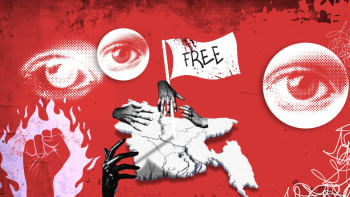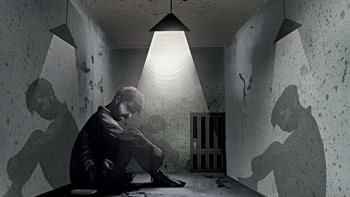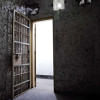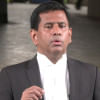Monuments of resistance and the politics of memory

It was no easy victory. After enduring massive carnage and 15 years of unjust dominance by a single political party, Bangladesh experienced a reincarnation. This resurgence, marked by bloodshed and violence, claimed the lives of individuals ranging from toddlers—like Zabir (6), Abdul (4), Roya (6)—to university students and civilians, totalling over a thousand. This shadhinota differs vastly from what the post-1971 generation knew. These young people did not seek martyrdom; they were killed, forced into it by police brutality—gunshots, severe burns, or shrapnel—in the homeland they thought would rightfully be a safe haven. Ultimately, the student movement—or rather, the student-led people's movement—triumphed on July 36 (August 5), 2024. These horrific yet historic moments must be memorialised. But where and how? How can we, as common citizens, claim our victory? Thus arises the urgency of spatial claim/reclaim/[un]claim to reveal a fresh historical narrative—one that does not disregard 1971 but builds upon it. This nuevo-nationalism version 2.0 deviates from the Mujib-centred, post-1971 chetona (spirit) and its mono-narrative of Bangladeshi nationalism.
Immediately after the revolution, people spontaneously began to historicise and monumentalise urban spaces across broiling Bangladesh. Spaces of protest, martyrs, and carnage were transformed into markers and monuments, turning the major towns and cities—and particularly Dhaka—into open-air museums. These ad-hoc actions are techniques for historical recording. Notable examples include the commemorations of Abu Sayed (1999-2024) and Mir Mahfuzur Rahman Mugdho (1998-2024).
Sayed, just 25, died after enduring baton charges and being shot four times, becoming what Shahidullah Faraj called the "hero of the generation." His name has now been immortalised. The people renamed the Rangpur Park intersection to "Shaheed Abu Sayed Chattar" in his honour. On July 18, Mugdho was killed by police while distributing water to protesters. His death further galvanised people. In his memory, "Shib Bari Mor" in Khulna was renamed "Shaheed Meer Mugdho Chattar," Dhaka's Zero Point became "Mugdho Chattar," and the Bangabandhu Mukta Mancha in Uttara was renamed "Mugdho Mancha." Police brutality, deaths, and political caricatures have been illustrated and replicated through recurring visual representations—wall paintings, cartoons, and street art—across Dhaka and beyond. These artworks, often created by hand and reproduced shortly after the incidents, carry a weight that counters Walter Benjamin's The Work of Art in the Age of Mechanical Reproduction. Though transient, the proliferation of these artefacts plays a crucial role in ensuring that Bangladesh's evolving narratives are not forgotten. In this way, these spatial moments serve as agencies of historical transference and identity-making. Thus, they also become powerful catalysts and iconoclastic gestures challenging the pervasive dominance of Mujib's omnipresence, propagated during Awami autocracy. Like museum pieces, these artworks act as critical historical spectacles. Dr Yunus, as head of Bangladesh's interim government, carried this message in mobile form—a book—to the UN meeting in New York, further underscoring the significance of these art forms.
One space that must be uncovered and integrated into Bangladesh's evolving, multi-faceted narrative is Aynaghar (House of Mirrors). Under Sheikh Hasina's regime, the country became infamous for forced disappearances, commonly referred to as goom. Much like India's Kaala-Pani—a hidden cellular jail and notorious torture site used during the British period—Aynaghars were a network of clandestine detention centres where political detainees or even ordinary people deemed political threats were held. Aynaghar became a site of psychological torture, extreme suffering, and death—where many were subjected to extrajudicial killings for political gain. While some prisoners eventually returned, many did not. Like the concentration camps of the Holocaust, Aynaghar rightfully demands to be a museum for the atrocities.
However, transforming Gono Bhaban—literally meaning the "People's House"—into a museum presents a conundrum. Should it be reclaimed, or perhaps unclaimed, for "Bangladesh 2.0?" Ironically, despite its name, Hasina asserted ownership of it in a meeting held inside Sangsad Bhaban in 1991. Often referred to as "Hasina's Palace," it flares up outrage and calls for public possession. On September 5, the interim government announced Gono Bhaban would become a museum.
Immediately after Hasina's escape, Gono Bhaban was flooded by thousands. Many looted whatever they found—including even pet ducks. While the looting can be seen as a momentary act of vengeance and a release of pent-up frustration, it holds no deeper connection to Bangladesh's collective memory. Thus, memorialising Gono Bhaban as a museum risks evoking negative memories. Memorialising a space with such fear could wrongly shape the collective memory of a place where the public had little interaction in history. In that way, it may be counterintuitive to the monumental conquest, overshadowing the public struggle.
As educated citizens, we must remain vigilant about the significance of Gono Bhaban and the larger Sher-e-Bangla Nagar area. The building was specifically designed for the nation's leader by renowned modernist architect Louis I Kahn (1901-1974). Arguably one of Kahn's finest works, it deserves both scrutiny and preservation. It took 20 years of meticulous planning over more than 1,000 acres, including water strategies, infrastructure, and the careful demarcation of public and private spaces. Kahn instituted height restrictions and prohibited encroachments or unauthorised constructions through his design decisions. However, both BNP and Awami League governments have already breached these commitments.
Henry Wilcots (1928-2024), Kahn's right-hand man who oversaw the execution of the project, expressed his frustrations over the changes made to the Sangsad Bhaban premises. These included the construction of President Ziaur Rahman's mausoleum, the surrounding wall, temporary politicised gardens, and the encroachment to accommodate the metro-rail—a politicised Awami mega-project. To Wilcots, Kahn never envisioned the site for any political group or a singular person, and these alterations were made without his consultation.
Millions rejoicing the August 5 victory at Sangsad Bhaban Plaza signifies the enormous significance of Kahn's design in shaping our national consciousness. Hence, the removal of the wall and the opening of the space long-owed to the public is perhaps a more justified approach, aligning with Bangladesh's newly found independence. This might also be an opportunity to decolonise the substantial number of independence-war museums, many of which were built using public funds during the Awami era. The images and narratives once set out of visibility should now be included to reflect evolving Bangladeshi nationalism and identity. We can also fill the gaps with visuals (photos, newspaper clippings) that were once restricted. It is time to insert the unsung heroes alongside those who gave their lives in 1971 and 2024. Now is the prime time to claim, and even reclaim, what is rightfully ours, and to discard what no longer represents Bangladesh Version 2.0.
Dr Nubras Samayeen did her PhD in Bangladesh's capital complex, Jatiya Shangshad Bhaban, from the University of Illinois, Urbana-Champaign. She is the author of "Post-71: Photographic Ambivalences, Archives, and the Construction of a National Identity of Bangladesh."
Views expressed in this article are the author's own.
Follow The Daily Star Opinion on Facebook for the latest opinions, commentaries and analyses by experts and professionals. To contribute your article or letter to The Daily Star Opinion, see our guidelines for submission.


 For all latest news, follow The Daily Star's Google News channel.
For all latest news, follow The Daily Star's Google News channel. 










Comments